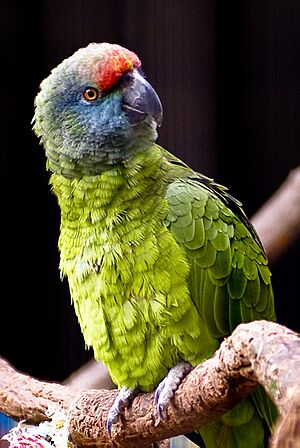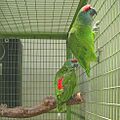Festive amazon facts for kids
Quick facts for kids Festive amazon |
|
|---|---|
 |
|
| A. f. bodini | |
| Conservation status | |
| Scientific classification | |
| Genus: |
Amazona
|
| Species: |
festiva
|
| Synonyms | |
|
|
The festive amazon (Amazona festiva), also known as the festive parrot, is a type of parrot. You can find these colorful birds in several South American countries. These include Brazil, Colombia, Ecuador, Bolivia, Guyana, Peru, and Venezuela.
Festive amazons love living near big rivers in forests. They especially like a type of forest called Várzea forest, which floods seasonally. Sometimes, they also live in coastal mangrove forests, especially in a place called Amapá. There are two main kinds, or subspecies, of festive amazon: A. f. festiva and A. f. bodini.
Contents
About the Festive Amazon Parrot
Scientists give every living thing a special name. This helps everyone know exactly which animal or plant they are talking about. The festive amazon was first officially described in 1758 by a Swedish scientist named Carl Linnaeus. He gave it the scientific name Psittacus festivus. Later, it was placed in the group of parrots called Amazona. The word festivus means "festive" or "cheerful" in Latin.
Two Kinds of Festive Amazons
There are two recognized subspecies of the festive amazon parrot:
- A. f. bodini – This kind lives in eastern Colombia, eastern Venezuela, and Guyana.
- A. f. festiva – This kind lives in the western Amazon region.
What Do Festive Amazons Look Like?
Festive amazons are beautiful parrots. Both subspecies have deep blue feathers on the outer parts of their wings when they fly. They also have a red patch on their lower back, called the rump. However, this red patch is smaller in young parrots.
Differences Between Subspecies
The bodini subspecies has more red feathers on the front of its head. It also has more blue feathers on its face compared to the festiva subspecies. These small differences help scientists tell the two kinds apart.
Where Do Festive Amazons Live?
The festiva subspecies lives near rivers in the large Amazon Basin. This is a huge area of rainforest in South America. The bodini subspecies, on the other hand, lives near the Orinoco River. The Orinoco River is another major river system, mostly in Venezuela and Colombia.
Conservation Status of the Festive Amazon
For a long time, the festive amazon was considered a species of least concern. This meant there were plenty of them, and they weren't in immediate danger. You could even see them near big cities like Manaus and Iquitos.
However, things have changed. In 2012, the festive amazon's status was changed to vulnerable. This is because of the rapid deforestation happening in the Amazon. Also, these parrots are sometimes hunted. Scientists predict that the number of festive amazons will drop quickly in the coming years if these problems continue. Protecting their forest homes is very important for their future.
Images for kids







